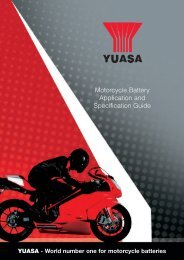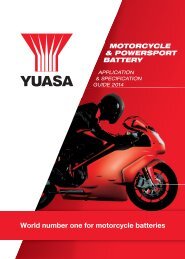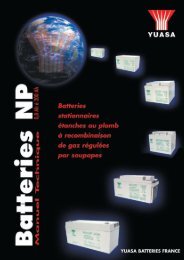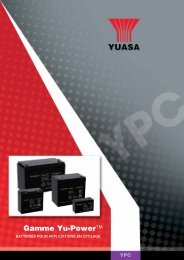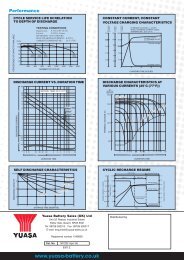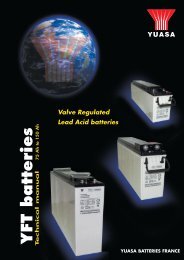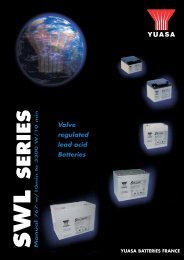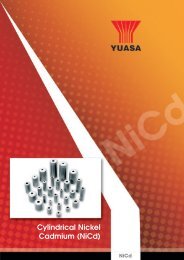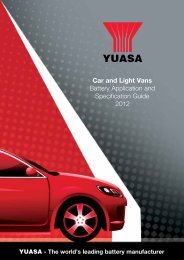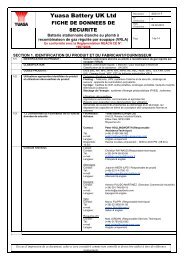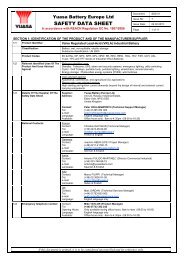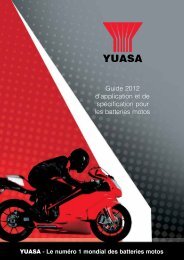YUASA - The world's leading battery manufacturer
YUASA - The world's leading battery manufacturer
YUASA - The world's leading battery manufacturer
Create successful ePaper yourself
Turn your PDF publications into a flip-book with our unique Google optimized e-Paper software.
How a Battery Works<br />
Information<br />
What Is a Battery?<br />
A <strong>battery</strong> is a device for storing electrical energy in a chemical<br />
form, and then releasing it as direct current in a controlled way.<br />
All types of batteries contain a positive and a negative electrode<br />
immersed in an electrolyte, the whole assembly being within a<br />
container.<br />
All Yuasa batteries are lead-acid batteries, which means that<br />
they have positive and negative electrodes made of lead<br />
compounds in a dilute sulphuric acid electrolyte.<br />
Lead-acid batteries are secondary batteries, which means that<br />
they can be recharged after they have been discharged.<br />
Primary batteries can be discharged only once and then have<br />
to be thrown away; examples are some types of torch and<br />
radio batteries.<br />
How a Yuasa Battery Works<br />
<strong>The</strong> positive electrode is made of lead dioxide and the negative<br />
electrode is made of porous lead.<br />
When an electrical load (for example lights or a starter-motor) is<br />
connected across the <strong>battery</strong>, a current flows through the<br />
electrolyte in the <strong>battery</strong> and through the external load. This<br />
causes the <strong>battery</strong> to discharge, which results in the chemical<br />
composition of both the electrodes changing to lead sulphate.<br />
A <strong>battery</strong> can be charged by putting a current through the<br />
<strong>battery</strong> from an outside source of electricity such as an<br />
alternator, dynamo or charging unit. This converts the lead<br />
sulphate back to the original materials of lead dioxide and<br />
porous lead.<br />
As the <strong>battery</strong> becomes charged, the electricity begins to<br />
decompose (hydrolyse) the water in the electrolyte into its<br />
constituent elements of hydrogen and oxygen, which are<br />
released as gas. This is why a <strong>battery</strong> gases when it is charged.<br />
What is a Battery Made of?<br />
Grids<br />
As the positive and negative electrodes are made of weak<br />
materials, they need a mechanical support which is provided<br />
by a grid made from a lead alloy; lead on its own would be too<br />
soft.<br />
In addition to providing a support for the electrodes (the active<br />
material), the grid also conducts electricity from the electrodes<br />
to the outside load.<br />
Electrodes<br />
<strong>The</strong> electrodes are initially made from a mixture of lead oxide<br />
and lead sulphate. This is converted into lead dioxide in the<br />
positive plate and porous lead in the negative plate when the<br />
<strong>battery</strong> is initially charged.<br />
<strong>The</strong> negative electrode also contains small amounts of<br />
additives to give the <strong>battery</strong> a good discharge performance at<br />
low temperatures to improve starting.<br />
<strong>The</strong> combination of grid and electrode is normally called a<br />
plate.<br />
Electrolyte<br />
<strong>The</strong> electrolyte is dilute sulphuric acid. This acts as a conductor<br />
to transport electrical ions between the positive and negative<br />
plates when the <strong>battery</strong> is being charged or discharged.<br />
<strong>The</strong> acid also takes part in the discharge as the sulphate ions<br />
react chemically at the electrodes to produce lead sulphate.<br />
Separator<br />
<strong>The</strong> separator is an insulator placed between the positive and<br />
negative plates to prevent them shorting together.<br />
<strong>The</strong> separator needs to be microporous with very small holes to<br />
allow the ions to flow through the separator from one plate to<br />
another. It also needs to be able to resist the high temperatures<br />
and strongly acidic oxidising conditions that occur in a <strong>battery</strong>.<br />
Most modern separators are made of microporous<br />
polyethylene, which has the right properties to meet the<br />
demanding conditions within the <strong>battery</strong>.<br />
Container and Lid<br />
<strong>The</strong>se are normally made of polypropylene, which is a light but<br />
strong plastic. Unlike some plastics, it does not become brittle<br />
when it is cold, and so can resist knocks during handling. It is<br />
not attacked by acid and it can also withstand the fluids (petrol,<br />
diesel, brake-fluid, antifreeze) normally found on a vehicle.<br />
What Makes a Battery Maintenance-Free?<br />
30 years ago, batteries lost water at a high rate, and motorists<br />
were advised to check the acid level as one of their weekly<br />
checks; modern maintenance-free batteries need no water<br />
addition throughout their life under normal operating<br />
conditions. Incidentally, during the same period, <strong>battery</strong> life has<br />
doubled from 2 years to 4-5 years.<br />
In the past, <strong>battery</strong> grids were made of an alloy of lead with 10<br />
per cent of antimony; the purpose of the antimony was to give<br />
rigidity as pure lead would be too soft on its own. Unfortunately,<br />
some of the antimony dissolved in the acid and resulted in the<br />
<strong>battery</strong> losing water.<br />
With improvements in <strong>battery</strong> technology, we have been able<br />
to reduce the antimony content from 10 per cent to 1.5 per<br />
cent, and this reduction has resulted in batteries that are low<br />
maintenance, needing only yearly attention.<br />
<strong>The</strong> latest improvement has been the use of 0.1 per cent of<br />
calcium as a hardening agent in grids in place of antimony; this<br />
causes less contamination of the acid and much reduced<br />
water loss, making the <strong>battery</strong> maintenance-free so no water<br />
needs to be added during its operational life.<br />
180




